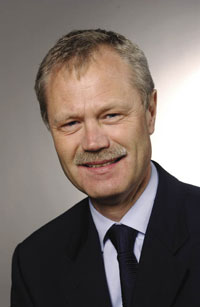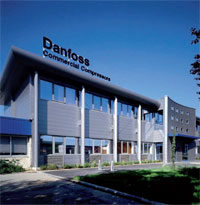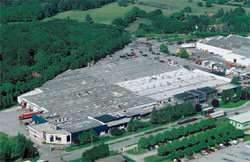Leif Flojgaard, President, Danfoss Commercial Compressors, speaks to CCME about his company’s contribution in reducing CO2 emissions
Leif Flojgaard, President, Danfoss Commercial Compressors, speaks to Climate Control Middle East about his company’s contribution in reducing CO2 emissions and how the commitment to the cause starts from within.
Danfoss has a CO2 emissions reduction target of 25% by 2025. What is the baseline?
 The group tries to reduce the climate impact of its own activities. Danfoss has a climate strategy, called “3×25”, which states that the group will reduce its CO₂ emissions from energy consumption, transportation of finished goods and business travel by 25%, and increase the share of CO₂-neutral energy by 25% before 2025, compared to emissions in 2007. This corresponds to a reduction of 1.5% of the CO₂ emissions annually.
The group tries to reduce the climate impact of its own activities. Danfoss has a climate strategy, called “3×25”, which states that the group will reduce its CO₂ emissions from energy consumption, transportation of finished goods and business travel by 25%, and increase the share of CO₂-neutral energy by 25% before 2025, compared to emissions in 2007. This corresponds to a reduction of 1.5% of the CO₂ emissions annually.
We focus on reducing our CO₂ emissions from energy-consuming processes and systems. In 2011, the company started a project with the objective of reducing the total energy consumption of the 15 largest factories by 20 to 25%. The first step is to incorporate energy-saving measures at selected factories in Denmark, Mexico and the United States (Arkadelphia). The second step is to review the factories in France, China and Loves Park in the United States to find energy savings.
An example of how we plan to achieve these results is the recent transfer of the scroll assembly line in Anse, France, to our site in Reyrieux, France. By consolidating the French scroll and reciprocating compressor factories at one single site in France, we also improve the operational and financial results of the company. The improvements will be found in the extensively optimised logistics flow.
What role do you see for the compressors segment of the business in helping achieve reduction in emissions?
According to the International Institute of Refrigeration (IIR), 80% of the greenhouse gases (GHG) in the refrigeration and air conditioning industry is released indirectly through the energy consumption of refrigeration and air conditioning systems.
We are developing compressors using more environment-friendly refrigerants, like R32 and R290. We continue to develop more efficient fixed-speed systems that reduce the primary energy input. We are offering the inverter scroll compressors, which consume energy as per the actual demand, and have better seasonal efficiency. Our S-series, dedicated to large commercial air conditioning, is the first compressor range totally compliant with the RoHS directive (Reduction of Hazardous Substances).
In the air conditioning industry, R32 is generally considered one of the most relevant choices to replace R22. R32’s ozone-depleting potential (ODP) is zero and its Global Warming Potential (GWP) is about one-third that of R22 and that of R410A.
Are you promoting the use of natural refrigerants for a more diverse range of applications besides commercial refrigeration?
Ammonia is the refrigerant with the longest presence in the industry. It has been in use for more than 100 years, thanks to its excellent properties. However, due to its hazardous nature, care must be taken in handling it, and it should only be done by a specially educated service force.
 The recent years’ focus on lowering refrigerants’ GWP, combined with increasing energy efficiency, has triggered research and pilot projects on commercial use of ammonia in combination with CO₂. We expect development within these smaller applications. But, of course, the technology has to be competitive.
The recent years’ focus on lowering refrigerants’ GWP, combined with increasing energy efficiency, has triggered research and pilot projects on commercial use of ammonia in combination with CO₂. We expect development within these smaller applications. But, of course, the technology has to be competitive.
CO₂ has been in our scope for 15 years, starting with the automotive interest in the 1990s. To make a long story short, the actual situation in the EU is that a large majority of supermarket systems are built for CO₂, either in cascade with R290 or HFCs or as pure CO₂ systems. Systems are constantly developing and efficiencies continue to increase.
Hydrocarbons, like R290 and R1270, are excellent refrigerants with high energy efficiencies. The flammability of hydrocarbons is, of course, a concern for larger installations. Proper installment, according to the European EN378 standard, is necessary, as well as the maintenance of the systems.
I can share with you that we have the first European full-fledged, accredited ATEX laboratory for tests of systems driven by natural refrigerants, like R290, among others. We were among the first providers, with our partner Secop, to offer R290 compressors for refrigeration.
What is the profile of the use of scrolls for air conditioning?
The use of scrolls is dominating the air conditioning markets globally and in the Middle East. The improvements pursued in the scroll technology for air conditioning are focused on increasing the efficiency of the fixed-speed systems, lowering primary energy consumption, improving human comfort with inverter scrolls, using more environment-friendly refrigerants and improving acoustic performance to respect the environment in residential areas.
Will we be seeing a more intense drive in this direction in the Middle East?
In the Middle East, we observe a refrigerant transition from R22 to R410A. To meet the needs of the region, Danfoss has a complete range of scroll compressors for R410A from 3 to 40HP in single configuration, which can be arranged in tandem and trio up to 120HP in a single circuit. In the case of multiple circuits, the capacity can be much higher. Danfoss has developed a patented system for higher compressor efficiency in manifold configurations.
Is Danfoss considering any low-GWP, low-ODP synthetic alternatives that will raise the bar further in terms of energy efficiency?
Danfoss is investing in the development of compressors and controls capable of operating with R32. R32 has a better system efficiency and needs a smaller refrigerant charge compared with the current alternatives. However, it’s mildly flammable and the compressor discharge temperature is higher. Consequently, the application of R32 necessitates changes in the current scroll compressors as well as in the lubricant oil and refrigeration systems.
 An R32 compressor using liquid injection overcomes the temperature limitation and greatly enlarges the operating map, so that it can operate efficiently even in extreme conditions. From the system perspective, there is an additional injection valve to inject liquid into the compressor to reduce the discharge gas temperature. The injected mass flow rate can be easily controlled by the injection valve. As a result, the liquid injection is a simple, economic, reliable and efficient option for R32 compressors. We have also developed a full programme of controls for R32.
An R32 compressor using liquid injection overcomes the temperature limitation and greatly enlarges the operating map, so that it can operate efficiently even in extreme conditions. From the system perspective, there is an additional injection valve to inject liquid into the compressor to reduce the discharge gas temperature. The injected mass flow rate can be easily controlled by the injection valve. As a result, the liquid injection is a simple, economic, reliable and efficient option for R32 compressors. We have also developed a full programme of controls for R32.
At a Danfoss technical seminar three years ago in Dubai, the audience seemed more interested in reliability than energy efficiency. Indeed, representatives from supermarkets who attended the seminar wanted compressor manufacturers to address the issue of how supermarkets were losing over a 100 compressors a year owing to reliability issues, as well as faulty installation, maintenance and after-sales service practices. What steps have you taken to make Danfoss compressors more reliable and appealing?
It is a well-known fact in the industry that refrigeration applications are more challenging in the field from a reliability point of view. All major compressor as well as system manufacturers experience this issue.
At the technical seminar to which you are referring, it was the general industry of compressors and system manufactures that were questioned. Danfoss compressors are qualified as per very strict reliability standards. We are constantly improving our products on this aspect via an increasingly robust design. Furthermore, Danfoss has decided to roll out the ISO TS Quality standard in all our factories globally. This standard is from the automotive business, and is, as such, the best system to ensure a high level of quality for each product. To ensure good training, Danfoss conducts training seminars and offers the Danfoss e-learning programme. We also have qualified field service engineers to provide technical support to our customers, especially in the phase where new systems and units are qualified.
Danfoss Commercial Compressors is driving the technological change in the market from fixed-speed compressors to the more energy-efficient solutions in inverter scroll compressors with prequalified drives. We are able to do so, of course, thanks to the products and the technical support that we offer in the design phase of the systems. It is the remit of Danfoss to partner with the OEMs to deliver high-quality products and services to ensure the best performance and reliability.
Copyright © 2006-2025 - CPI Industry. All rights reserved.